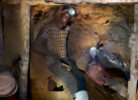The wall texts throughout the exhibition illustrate the complexity of the global supply chain for gold and rare minerals. – Scroll down for additional information.
In order to improve working conditions, health care and safety of artisanal miners, local and national initiatives aim at regulating supply chains, traceability and increased due diligence in the trade of gold and rare minerals. Other approaches, particularly at the international level, seek to hold electronics companies more accountable. Finally, consumers are asked to shop more consciously and recycle.
The impact of the various solutions often fails due to the complexity of the circumstances. One example is part of a 2010 U.S. law that sought to stop the flow of money from mineral mining in the Congo to armed groups. However, the legislation ultimately had the effect of hitting the poorest laborers in artisanal mining the hardest, while increasing smuggling of rare minerals and gold and missing the goal of stopping the flow of money into war funding.
Much of the recent regulation around minerals has focused on the link between mineral extraction and political violence; so-called ‘conflict minerals’. The Dodd-Frank Act (2010) has introduced legal obligations for companies registered with the Securities and Exchange Commission (SEC) to disclose supply-chains for certain minerals to verify whether they originate from DRC. This involves proof of due diligence in the supply chain and descriptions of product components. Section 1502 of this Act defines as ‘conflict minerals’ “columbite-tantalite (coltan), cassiterite (tin), wolframite (tungsten), gold or their derivatives; or any other mineral or its derivatives determined by the US Secretary of State to be financing conflict in the DRC or an adjoining country”. It strictly defines conflict financing as the control of armed groups over exploitation and taxation between a ‘conflict mine’ and the point of export in the DRC or an adjoining country. Hence, the definition excludes extortion practices by national armies and disregards violent corruption occurring outside the narrow commodity chain from the mine to exportation. The key motivation for this definition, Congress writes, is that the exploitation and trade of ‘conflict minerals’ by armed groups in DRC helps finance conflicts characterized by extreme levels of sexual violence – a particularly one-sided assertion, given that not only militias but also the national army are engaged in such violence across the country - and not just in areas characterized by the preponderance of mining activity.
The EU also adopted a new regulation in 2017 that aims at addressing the links between political violence and mineral extraction. It became applicable in 2021 and claims to concern 600 to 1000 EU importers – including around 500 smelters and refiners of tin, tantalum, tungsten and gold, whether they are based in the EU or not. It requires these importers to follow a 5-step «Due Diligence» framework drawing on the OECD work from the last 15 years, which helps them identify and address human rights violation risks within their supply chains.
To help importers, a list of mineral-producing countries wherefrom imports are considered “risky” has been established. It is an important step forward, but its efficacy needs to be monitored, not least because of the way hybrid and voluntary measures are combined and the way it impacts on the weakest producers – namely small-scale mining workers, as has been shown for other similar schemes.
Parallel to general regulations, the certified product market also emerged in the mid-2000s. In the gold supply chain, for example, the most prominent label is Fairmined, which is headed by a Colombia-based NGO called the Alliance for Responsible Mining, and which has so far produced around 100Kg of certified gold around the world. Fair Trade also produces certified FairGold products. These are mostly sought after by small jewelers and refiners, and in electronics more recently (e.g. within Fairphone), while big brands and banks and financial institutions are harder to bring in the certified supply chain. In Switzerland the Better Gold Initiative brings together supply chain actors around the improvement of gold production, although it is limited to commercial actors based in Switzerland, which risks supporting the latter more than it does small-scale miners around the world.
More Information: Alliance for Responsible Mining, FairGold, Fairphone, Better Gold Initiative
More about the global context:
Artisanal vs. Industrial Mining
Stigmatized Workers
How About Switzerland?
Livelihoods for Millions
Share your impressions, observations and questions on our visitors' comments page.
Department of Geography, University of Zurich:
Research, interviews, 3D scans, videos, photographs: Gabriel Kamundala, Department of Geography, UZH
Supervision and textual content: Dr. Timothy Raeymaekers, Department of Geography, UZH,
Dr. Muriel Côte, Associate senior lecturer, Department of Human Geography, University of Lund
Research partners:
University of Zimbabwe
University of Ouagadougou I
Institut National des Sciences des Sociétés (Burkina Faso)
Groupe d’Etudes sur les Conflits et la Sécurité Humaine (DR CONGO)
Immersive Arts Space, Zurich University of the Arts ZHdK:
Scenography: Mariana Vieira Gruenig
Interaction Design, 3D Experience: Chris Elvis Leisi
Spatial Augmented Reality Engineer: Florian Christoph Bruggisser
Video editing, storytelling: Alan Sahin
Sound design: Patrycja Pakiela
Additional on location audio recordings: Alfred Borauzima
Translation, proofreading: Alliance Riziki Murhula, Edward Wright
Voice over: Shabnam Chamani, Rino Hosennen
Chief technician: Sébastien Schiesser
Production manager: Kristina Jungic
Project lead: Prof. Christian Iseli
